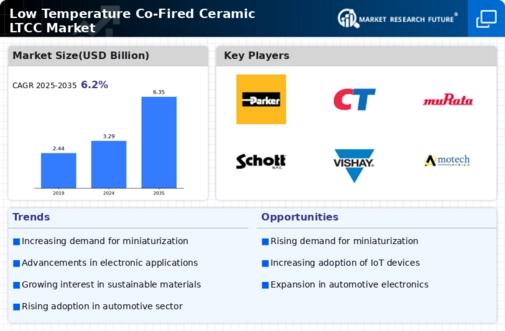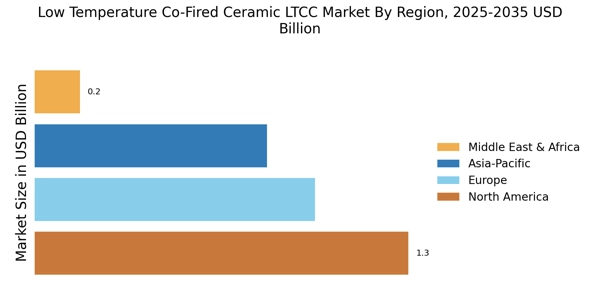Focus on Energy Efficiency
The Low Temperature Co-Fired Ceramic LTCC Market is increasingly driven by a focus on energy efficiency in electronic devices. As energy consumption becomes a critical concern for manufacturers and consumers alike, the demand for materials that enhance energy efficiency is rising. LTCC technology allows for the integration of passive components, which can lead to reduced power loss and improved overall efficiency in electronic circuits. This trend is particularly relevant in sectors such as renewable energy and electric vehicles, where energy efficiency is paramount. The market for energy-efficient devices is expected to grow substantially, potentially reaching a multi-billion dollar valuation, thereby creating favorable conditions for the LTCC market.
Integration of IoT Devices
The Low Temperature Co-Fired Ceramic LTCC Market is significantly influenced by the integration of Internet of Things (IoT) devices across various sectors. As industries increasingly adopt IoT solutions, the demand for compact and efficient electronic components rises. LTCC technology facilitates the development of smart sensors and devices that require minimal space while maintaining high performance. The proliferation of IoT applications in sectors such as healthcare, automotive, and smart cities is likely to drive the LTCC market forward. Analysts suggest that the IoT market could reach trillions in value, thereby creating substantial opportunities for LTCC manufacturers to cater to this expanding demand.
Advancements in Telecommunications
The Low Temperature Co-Fired Ceramic LTCC Market is poised for growth due to advancements in telecommunications technology. The demand for high-frequency and high-speed communication systems is escalating, particularly with the rollout of 5G networks. LTCC materials are well-suited for RF applications, providing excellent performance in terms of signal integrity and thermal stability. As telecommunications infrastructure expands, the need for reliable and efficient components becomes paramount. The market for LTCC is expected to benefit from this trend, with projections indicating a substantial increase in the adoption of LTCC substrates in communication devices, potentially reaching a market value of several billion dollars by the end of the decade.
Growing Automotive Electronics Sector
The Low Temperature Co-Fired Ceramic LTCC Market is benefiting from the rapid growth of the automotive electronics sector. With the increasing incorporation of advanced electronic systems in vehicles, such as infotainment, navigation, and safety features, the demand for reliable and efficient materials is on the rise. LTCC technology is particularly advantageous in automotive applications due to its ability to withstand harsh environments and provide high reliability. The automotive electronics market is projected to grow at a robust pace, with estimates indicating a potential market size exceeding hundreds of billions by the end of the decade. This growth is likely to enhance the adoption of LTCC solutions in automotive applications.
Rising Demand for Consumer Electronics
The Low Temperature Co-Fired Ceramic LTCC Market is experiencing a surge in demand driven by the increasing consumption of consumer electronics. As devices become more compact and multifunctional, manufacturers are seeking materials that can support high-density interconnections and miniaturization. LTCC technology offers a unique advantage due to its ability to integrate passive components, which is essential for modern electronic devices. The market for consumer electronics is projected to grow significantly, with estimates suggesting a compound annual growth rate of over 5% in the coming years. This growth is likely to propel the LTCC market, as manufacturers prioritize efficiency and performance in their products.

















Leave a Comment